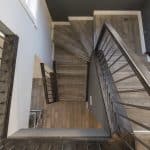Contents
There are several basement types, and it’s important to understand the differences between them. For example, knowing the differences between a full basement and a partial basement will help you ask the right questions of your contractor and determine which type of basement best suits your needs.
Every homeowner has different preferences, but what may be beneficial to one may only sometimes work for another. It depends on the features of the home, lifestyle, aesthetic preferences, budget, and other factors.
So Many Basement Types, So Little Time
Partial basements offer a compromise between cost and functionality. They extend only under a portion of the house, providing limited space for storage or utilities.
Homeowners might choose this type if they desire some basement benefits without the total investment. These basements can enhance a home’s value by adding valuable square footage, though less than a full basement would.
Full basements
Full basements run underneath a home’s entire footprint, offering maximum additional space. They are ideal for families looking for extra living areas, workshops, or storage.
A total basement significantly boosts property value due to the increased living space and versatility it provides.
Walkout basements
Walkout basements are unique because one or more walls have direct access to the outside, often leading to a patio or backyard. This type is trendy in hilly areas where the landscape allows natural light and exit points.
They not only add considerable value but also enhance a property’s aesthetic appeal, making it more desirable in the real estate market.
Crawlspaces
Crawlspaces are less about additional space and more about accessibility to house utilities. These shallow spaces allow for easy maintenance access but need to be more suitable for living or storage purposes.
While they don’t add much in terms of square footage, their utility access can be a selling point for buyers.
Storm shelters
In regions prone to severe weather, storm shelter basements provide safety and peace of mind. These reinforced spaces are designed to withstand extreme conditions, prioritizing the occupants’ safety over other uses.
Homes with storm shelters may see an increase in value due to this added safety feature.
Fixing leaky basements
Addressing water issues in any basement type is one of the first things to maintain structural integrity and prevent mould growth.
How to tackle a leaky basement from the inside:
- Identify sources of moisture using humidity trackers;
- Seal cracks with waterproof mastic;
- Apply interior waterproofing coatings on walls;
- Make sure proper drainage away from foundation walls.
These steps can mitigate water damage and protect your home’s foundation effectively. Of course, you can try to DIY. If you have skills and you are willing to spend time and effort, you will indeed manage. But it is better to entrust this work to professionals.
Full vs Partial Basements
Full basements extend under the entire house. They are fully excavated, allowing for higher ceilings and a completely livable space. Their construction requires more extensive digging and foundation work.
Partial basements, on the other hand, cover only a portion of the house’s footprint. Often found in older homes or those built on sloping lots, these basements may serve as crawl spaces or storage areas. The reduced excavation and foundation requirements make them less invasive to construct.
Cost implications
Opting for a full basement significantly impacts the overall cost of building a home. The additional excavation, concrete, and labour contribute to higher upfront costs. However, this investment can pay off by increasing the home’s total livable space and potential resale value.
Partial basements require less financial outlay due to their smaller size and reduced construction needs. Homeowners might prefer this option when budget constraints exist or when the terrain does not favour a full basement.
Space utilization
Full basements offer vast potential for additional living space. Homeowners can convert these areas into bedrooms, entertainment centers, or even rental units. This flexibility makes full basements attractive for families needing extra room to grow.
Partial basements provide limited space that is often relegated to storage or mechanical uses. However, they can be ideal for homeowners seeking only to add a small amount of storage or utility space without altering the entire basement foundation.
Functionality and light
Daylight basements, a variant of partial basements, feature one or more walls with external windows due to their construction on sloped lots. This design brings natural light into the space, making it more suitable for habitation than traditional dark basements.
Full basements can also incorporate windows and external doors if designed as walk-out or look-out basements. These features enhance functionality by improving access and allowing natural light, transforming the basement into an inviting part of the home.
Why You Can’t Live in A Crawlspace?
Crawl spaces serve specific functions in home construction. They allow access to plumbing, electrical systems, and HVAC components. This space provides a buffer between the ground and the living area, protecting the home from moisture and pests.
Crawl spaces are not designed for occupancy. Their low height makes them impractical as livable space. Moreover, they lack proper insulation, making them unsuitable for comfortable living conditions.
Moisture control
Maintaining a crawl space makes a home integrity. It would be best if you had good ventilation to keep moisture from accumulating. With it, mould and wood rot can maintain the house’s structure.
Homeowners often install vapour barriers to minimize moisture penetration. Regular inspections ensure that these spaces remain dry and ventilated, safeguarding the home’s foundation and air quality.
Pros and cons
Opting for a crawl space over other basement types has its advantages and disadvantages. On the plus side, crawl spaces elevate the home, providing flood protection in certain areas. They are also less expensive to construct than full basements.
However, without diligent maintenance, crawl spaces can become moisture havens, leading to structural issues and decreased air quality inside the home. The choice between a crawl space and a basement largely depends on geographical location, budget constraints, and personal preferences.
Basement underpinning Toronto
In Toronto, converting a crawl space into a basement is a popular underpinning method. This transformation begins by excavating beneath the crawl space. Contractors then build walls to create a new, livable basement space.
For such projects, hiring professionals like WillFix is advisable. We possess the expertise required for successful basement conversion and ensure safety standards are met throughout the process.
Cellar Basics
Cellars, often confused with basements, have their characteristics. They are primarily used for storage space, not living. Unlike basements, cellars usually have more humidity and less natural light. This makes them ideal for storing wine, canned goods, and other non-perishable items.
Their floors are typically made of simple dirt or gravel, unlike the finished floors found in modern basements. However, some homeowners choose to install a concrete floor with a vapour barrier to reduce moisture.
Traditional uses
Historically, cellars served as crucial storage areas. Before the advent of refrigeration, they were the coolest places in a home. Families stored fruits, vegetables, and meats here to keep them fresh longer. Wine enthusiasts also used cellars to age their collections properly.
Root cellars were typical in many old homes. They had strategic ventilation systems to regulate temperature and humidity. These traditional uses underscore the cellar’s role in self-sufficiency and household management.
Modern uses
Today’s cellars have evolved beyond mere storage spaces. Many homeowners transform them into specialized rooms. Wine cellars with controlled climate settings are popular among connoisseurs.
Others convert these spaces into secure storage for valuables or emergency supplies. The key is maintaining the right conditions to protect what’s inside. Innovative designs now incorporate basement types with hybrid functions, blending storage with utility spaces like laundry rooms or workshops.
Health considerations
Installing a vapour barrier on the floor and walls helps mitigate this risk of mould growth by preventing moisture from seeping in. Proper ventilation is also essential to circulate air and reduce humidity levels. As preventive measures, homeowners should regularly inspect their cellars for signs of water damage or pest infestations.
Material Matters
Masonry block walls, precast panels, and poured concrete walls stand as the primary contenders in basement construction. Each material brings its own set of strengths to the table, directly influencing a basement’s longevity and resilience.
- Masonry block walls — a traditional choice for many years. They offer moderate durability but require more maintenance over time due to their tendency to absorb moisture. This characteristic can lead to mould growth, an important consideration for areas with high humidity or soil that retains water;
- Precast panels — an alternative, fabricated under controlled conditions to ensure uniform quality and strength. They resist moisture more effectively than masonry blocks, reducing the risk of mould and structural damage. Their pre-engineered nature simplifies installation but may involve higher upfront costs;
- Poured concrete walls — known for durability and seamless construction, which virtually eliminates potential weak points for water ingress.
These materials provide reliable protection against external influences, so experienced contractors use them to repair basements in all weather.
Cost analysis
Masonry block walls generally offer lower upfront costs compared to their counterparts but may incur additional expenses over time for waterproofing treatments and repairs.
Precast panels present a middle ground in terms of pricing. While their purchase price exceeds that of masonry blocks, they typically require less maintenance, helping homeowners save money in the long run.
Poured concrete walls command the highest initial investment among the three options discussed here. Yet, their unparalleled durability and minimal maintenance requirements can render them more cost-effective over decades of use. For people seeking a build-it-once approach, poured concrete provides compelling value despite its premium price tag.
Keeping It Unfinished
Favour an unfinished basement, and you can significantly reduce the initial construction costs. You don’t have to make the floor, drywall the walls, or run electricity like you would in a finished basement. This way, you can allocate your budget to other home improvement projects or save money.
Moreover, tax implications favour unfinished basements in many regions. Properties with less finished space often incur lower property taxes, providing long-term financial benefits.
Flexibility
An unfinished basement stands as a blank canvas for future renovations. It offers homeowners the chance to customize their living space as needs evolve without demolishing existing structures.
This flexibility is crucial for growing families or changing hobbies. Space can transform into anything from a workshop to a home gym at the owner’s pace and budget.
Storage solutions
Unfinished basements are practical for storage needs. Without the need for aesthetic finishes, these areas can efficiently house seasonal decorations, sports equipment, and other seldom-used items.
Strategic organization systems like shelving units improve this utility. They keep belongings accessible yet out of the way of daily activities.
Maintenance considerations
Preserving an unfinished basement requires attention to moisture control and pest prevention. Proper insulation and ventilation combat dampness that could lead to mould growth.
Regular inspections identify potential issues early, ensuring structural integrity remains intact. Sealing cracks and installing dehumidifiers further protect against moisture-related damages.
Conclusion
To make your home even more beautiful, it’s important to choose the right type of basement. Consider your personal needs, budget, and long-term plans to see what type of basement will work best for you and your home. When you’re ready to renovate your basement, contact us. The team of professionals is always happy to help! WillFix takes a personalized approach to waterproofing, treating each project as if it were their own home.

